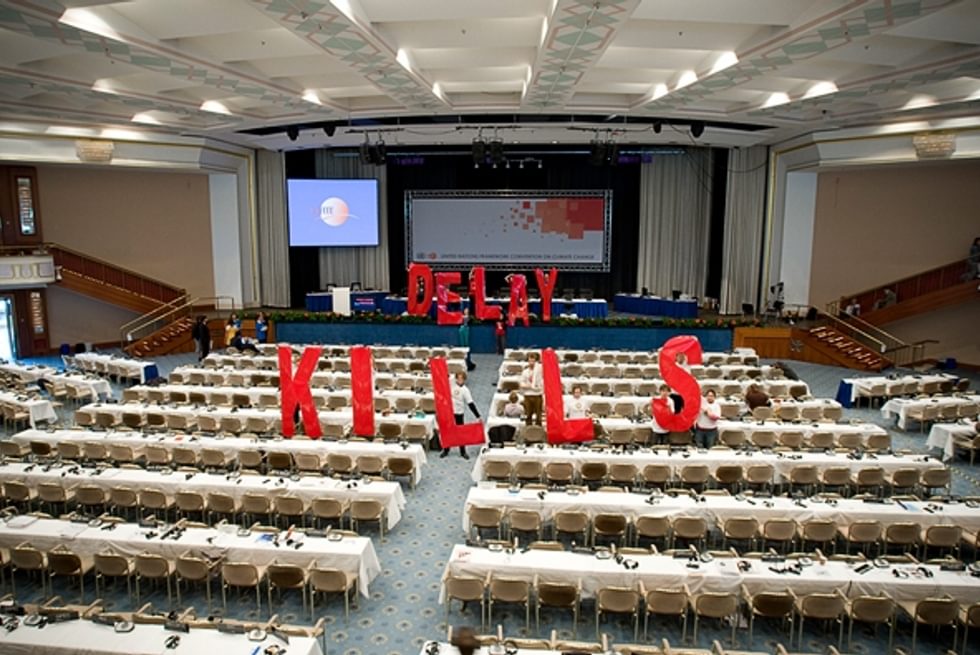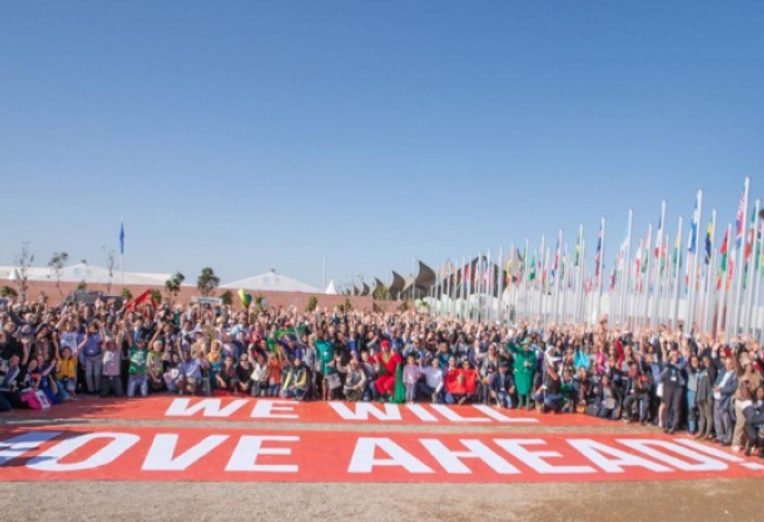Responding to Political Uncertainty at the United Nations Framework Convention on Climate Change Conference
From the Series: Negotiating the Crisis: Critical Perspectives on Climate Governance
From the Series: Negotiating the Crisis: Critical Perspectives on Climate Governance

The 2016 US Presidential elections took place on the second day of the 22nd Conference of the Parties (COP22) of the United Nations Framework Convention on Climate Change (UNFCCC) in Marrakech, Morocco. Attention immediately pivoted towards the election results. The meeting hosts sought immediately to provide counter-narratives. Clearly, COP22 leaders did not want their meeting’s narrative to be subsumed by American electoral politics, nor the idea that the Paris Agreement would stall one year after its negotiation. Simultaneously, the power dynamics within the COP—particularly as these pertain to the deployment of climate rhetorics within the UNFCCC organized conference venue—seemed to re-align as COP attendees considered their approach to climate action with Donald Trump as President of the United States. Formal political power in the UNFCCC resides with the pParties, or national representations, which is often underlined when delegates refer to a “party-driven process.” However, the participation of thousands of non-party “observers” to the meeting is about more than transparency: non-party observers are critical actors during the regular moments where Parties cease to engage in climate action.
National delegates went silent on the election at first: there was no immediate reaction. State negotiators were quiet until the higher-level diplomats arrived. Likely the delegates were consulting with their agencies in their capital cities, particularly the Obama-hired US delegation. The outward-facing silence of the delegations emphasized the remarkable shift in tone and expected political approach between the two US administrations. Delegates from other states, noting the key role of US leadership in international climate policy, waited for the US delegation to speak about the implications of the US presidential election.
The delegation’s first remarks took place two days after the election results were announced. Once it was apparent that the US delegation was now able to be forthcoming about the uncertainties the election of President Trump afforded US climate policy and their role in the UNFCC, other delegates used procedural techniques to continue handing the United States the floor. That is, Parties took turns asking nominal questions of the United States so that the speaker could continue beyond the few minutes conventionally allotted.
Over the weekend, heads of state and other high-level diplomats began arriving in Marrakech, allowing for proclamations that lower-level delegates did not have the authority to make. Then-French President Francois Hollande was the first to speak publicly on the election in the plenary hall, exerting France’s perceived responsibility over the Paris Agreement. Without mentioning the new American president by name, he noted that France plans to work with the new American administration to communicate that, in their view, the Paris Agreement is irreversible in law, in fact, and “in our minds.” Noting the context of COP21 in the immediate aftermath of Parisian terror attacks, it was clear that France felt protective of the agreement negotiated under their chairpersonship. Hollande concluded by noting that, “we are the guardians of the letter and spirit of the Paris Agreement, and we must remember what unites us, regardless of our differences…we must remember what unites us, and that, simply, is our planet.”
Conversely, environmentalist organizations were quick to find their narrative. Almost immediately after the election results were announced, global environmental NGOs began making statements that over the past few years, some Parties had “scaled back their climate ambition” as the debate over the Paris Agreement centered on what was acceptable to the United States. While US leadership on climate became stronger, other Parties became over-reliant on one state overall. NGO spokespeople then noted that other Parties were going to need to rethink diplomatic dynamics and that new leadership would need to emerge. And their lights trained on China for this role.
Demonstrations popped up in the venue multiple times a day. A day of action in solidarity with Standing Rock water protectors included a speech by Kayla DeVault, an Anishnabe and Shawnee engineer and journalist who noted that “we have dealt with Donald Trumps for centuries,” recounting resistance strategies as expertise borne out of necessity. Another group held a “die-in” in the conference walkways, blocking foot traffic to give pause for the human and nonhuman lives lost from climate changes. A group of young people ran around with face paint, painting large red zeros on the cheeks of anyone willing to support zero carbon emissions. However, even as the demonstrations proliferate inside the venue, other voices of dissent were found in large scale protests outside of the venue, in public spaces.
Credentialing activists suggests that allowing some protesters is a strategy intended to manage dissenters or to enroll them as allies into the geopolitical project. Such enrollment was clear on the penultimate day of COP22, when an email circulated to all state and NGO delegates, encouraging them to meet at the flags outside the venue the next day for the COP’s “largest family picture” as a display of unity and momentum. Traditionally, “family picture” participation is limited to high-level diplomats and heads of delegation. This photo was meant to be inclusive of all participants in the UNFCCC process. The resulting, exuberant display pairs nicely with the formal outcome of COP22, formally titled the Marrakech Action Proclamation.

The Marrakech Action Proclamation is at once idealistic and pragmatic (a pattern repeating throughout the UNFCCC meetings), stating that the momentum of the Paris Agreement “is irreversible—it is being driven not only by governments, but by science, business, and global action of all types at all levels.” This political affirmation of the Paris Agreement and the noted determination to implement it quickly and thoroughly is matched in the image of the “family photo.”
While there are plenty of concerns from environmentalist and social justice NGOs regarding the Paris Agreement, these actors have fought for and been given political space in international climate policy, literally and figuratively. The performances and participation of activists inside the COP venue may be trying to influence state delegates, but more directly, their high-profile, performative activities are media-ready—with a pool of credentialed reporters also looking for stories to tell. While the spaces they utilize within the COP may be marginal compared to other, more contained meeting spaces, they are also the most open and public. COP organizers plan for these spaces to enable these performances, which in turn form part of the rhetorical power of the diplomatic climate negotiators, cloistered in their bilateral meetings in the bowels of the space. These spaces-to-respond provide opportunities for actors to pressure official and authoritative positions within the COP and also constitute authority to the actors and the people who credential them.
These participants performing at the creative margins of the official conference site are not mere distractions or activist dressing on a technocratic spectacle, though they can be both of these, as well. That these actions took place in official, credentialed space, and that activists and diplomats flowed between their spaces bespeaks a long tradition of handing off the baton between governments and nongovernmental organizations during the regular climate withdrawals of the United States.